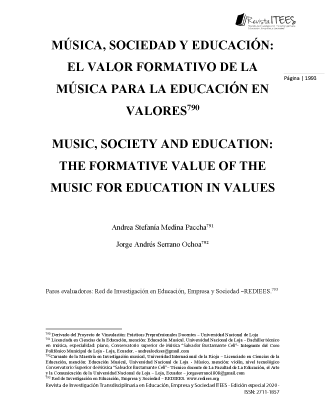CII. MUSIC, SOCIETY AND EDUCATION: THE FORMATIVE VALUE OF THE MUSIC FOR EDUCATION IN VALUES
##plugins.themes.bootstrap3.article.main##
Abstract
Education in the world today must take on great challenges to promote self-improvement,
the formation of active contributors in society implies the development of knowledge-hungry
subjects capable of responding to different social problems, without neglecting the ethical
and moral.
The Ecuadorian educational profile indicates as primary achievements the acquisition of
three fundamental values: justice, innovation, and solidarity, organizing the subjects in
curricular areas of knowledge. Music is part of Cultural and Artistic Education, a space that
promotes knowledge and participation in culture and contemporary art, which establishes a
relationship between local cultural expressions and national historical baggage in a
framework of enjoyment and respect for diversity and the expression, integrating the different
disciplines of art and culture in projects that tend to the development of: creativity, expression
and emotional training of students at all levels: intellectual, motor, auditory, sensorial,
linguistic and social development.
Being prevailing according to our curriculum to develop values and competences in the
student body, and, considering that the objective of music is to awaken and develop human
sensitivity and cognitive faculties, the purpose of this work is to carry out a descriptive study
of the formative value that the sound art of emotions has for education in values.
Download Statistics
##plugins.themes.bootstrap3.article.details##
education system, music education, values education, life skills
https://bit.ly/2QoMird
Barrio, R. (5 de julio de 2016). Pintamos la música. Obtenido de Repositorio UNICAN:
https://bit.ly/3gwQNKE
Bernal, C. (2016). Metodologia de la Investigacion. Colombia: Pearson.
Bravo, L. (23 de Julio de 2013). Cultura de masas. Obtenido de Slideshare:
https://bit.ly/31sYdKU
Caballero Lopez, J. E. (09 de 2009). El calzado laboral en el medio sanitario. Obtenido de
Medicina y seguridad del trabajo: https://bit.ly/3aZkLWE
Chaves, M. (Mayo de 2010). Música, Educación y Arte: Música y educación, la música y el
arte, musicoterapia, las artes en la educación, el arte y las nuevas tecnologías, el
grafitti y la educación popular. Dialnet(5), 22-43. Obtenido de artseduca.com:
https://bit.ly/3aZioDt
Conejo, P. (2012). El valor formativo de la música para la educación en valores. DEDICA:
Revista de Educação e Humanidades(2), 263-278. Obtenido de https://bit.ly/3liyVa5
Consejo Nacional de la Cultura y las Artes. (2016). el aporte de las artes y la cultura a una
educación de calidad. Santiago de Chile, Chile: Ograma. Obtenido de
https://bit.ly/32regbs
Cuadra, C., Lasheras, A., Marsal, R., & Royo, C. (2015). Oikonomía: cuidados,
reproducción, producción (Primera ed.). (P. URV, Ed.) Tarragona: Publicacions
URV. doi:10.17345/9788484243755
Delgado, P. (14 de Marzo de 2019). Observatorio de innovación educativa. Obtenido de
Tecnológico de Monterrey: https://bit.ly/32wpWK5
Eisner, E. (1995). Educar la visión Artística. Barcelona: Ediciones Paidós.
Herrera, M., & Cochancela, M. (5 de Febrero de 2020). Aportes de las reformas curriculares
a la educación obligatoria en el Ecuador. Scientific, 5.
doi:https://doi.org/10.29394/Scientific.issn.2542-2987.2020.5.15.19.362-383
Icasa, J. (2004). Maravilloso Ecuador: El hombre en el Ecuador (Vol. 1). (E. Ltda., & S. L.
Bustamante Editores, Edits.) Bogotá, Colombia: Círculo de Lectores.
Insaurralde, A. (2012). La música como medio social y cultural. Obtenido de Literarte:
https://bit.ly/3lkuOdJ
Jauss, H. (2002). Pequeña apología de la experiencia estética. Barcelona: Paidós ibérica.
John, A. (2016). Normas Basicas de Higiene del Entorno en la atención sanitaria. India:
Organizacion Mundial de la Salud. Obtenido de https://bit.ly/34CfBPo
Marsol, M., Del Mar Prieto, M., Alonso, D., & Marín, M. (25 de Mayo de 2020).
Gaoantropología. Obtenido de https://bit.ly/3jc3SLa
Ministerio de Educación. (2016). Currículo de los niveles de educación obligatoria.
Obtenido de eucación.gob.ec: https://bit.ly/32tAhpP
Ministerio de Educación. (2016). MINEDUC. Obtenido de Educación.gob.ec:
https://bit.ly/31w6Og0
Pérez, A. (30 de junio de 2011). Los valores: ¿de dónde vienen y hacia dónde van?
Strategos(6), 13-21. Obtenido de https://bit.ly/31vM3Ry
RAE. (2014). Real Academia Española. Obtenido de https://dle.rae.es/curr%C3%ADculo
Rodríguez, S. (s.f.). Guía de orientacón: importancia de la música en la educación. Obtenido
de Emagister: https://bit.ly/2ECvL0d
Tylor, E. (1871). La ciencia y la cultura: El concepto de cultura: textos fundamentales.
Barcelona: Anagrama.
Vilches, N. (2004). Una revisión y actualización del concepto de Currículo. TELOS: Revista
de Estudios Interdisciplinarios en Ciencias Sociales, 6(2), 194 -208. Obtenido de
https://bit.ly/3lmNSbm





